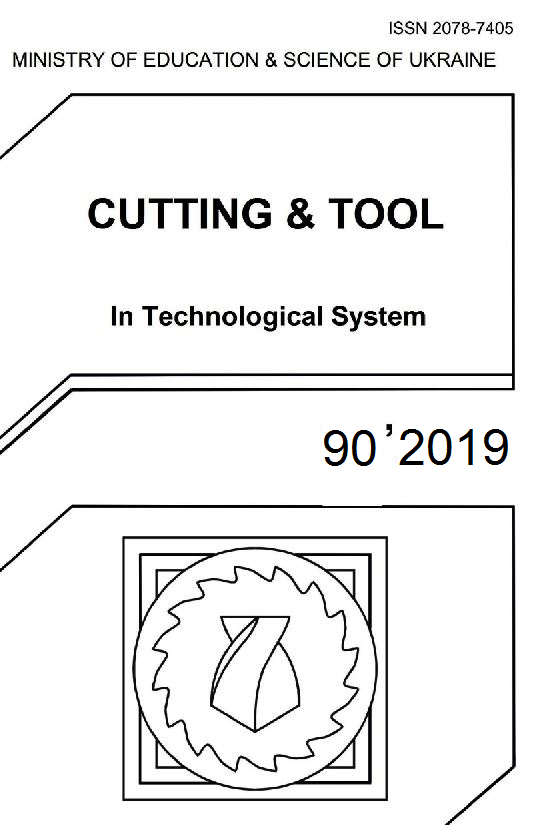RESEARCH OF DYNAMIC PHENOMENA OCCURRING DURING INTERMITTENT GRINDING
DOI:
https://doi.org/10.20998/2078-7405.2019.90.12Keywords:
cutting ledge, irregular circle, elastic systems of the machine, shock resonance,Abstract
The purpose of scientific research is to determine the conditions for the creation in the elastic system of useful vibrations that promote self-sharpener the cutting microrelief of the intermittent circle, and the detection of the conditions for appearance the shock and parametric resonances. It was established that with the increase of the circumferential speed of the grinding discontinuous circle VKR, the amplitude of forced oscillations A decreases, and the regions of parametrical stability of the system of the grinding machine are shifted in the direction of decreasing the number of slots n on the working surface of the circle. It has been established that in the studied intervals of numbers of cutting protrusions 5≤n≤40 and the discontinuity factor 0,3≤N≤40, with the decrease of the limb depth of cutting tL, the range of variation of amplitudes of forced oscillations A is narrowed, and the boundaries of the regions of the parametric stability of the system of the machine are expanded. It has been established that in order to maintain the amplitude of the forced oscillations A at a constant level and to prevent the exit from the parametric stability zone of the elastic system, it is necessary, when H- increasing the factor of discontinious N to decrease the number of openings on the discontinious grinding tool. It is established that with the increase in the number of cutting protrusions n in a discontinuous circle, the amplitude of forced oscillations A is decreasing, and the boundaries of the stability regions are expanded. Conditions of discontinuous grinding are found, where in the elastic system of the grinding machine there is no shock and parametric resonance and there is the possibility of self-sharpening of the cutting microrelief of the working surface abrasive tool during its operation.References
Novoselov, YU.K. Stohasticheskaya diagnostika vzaimodeystviya instrumenta i zagotovki pri kruglom narujnom shlifovanii /YU.K.Novoselov, S.M.Bratan//Suchasnі tehnologії u mashinobuduvannі: Zbіrnik naukovih prats. Harkіv: NTU «HPІ», 2007. – S. 91-102.
Bratan, S.M. Analiz vliyaniya kolebaniy, peredavaemyih cherez fundament stanka, na kachestvo protsessa shlifovaniya/S.M.Bratan, E.A.Vladetskaya//Vestnik NTU «HPІ». 2008. №35. S.13-22.
Zubarev, YU.M. Raschet oblasti ustoychivogo protsessa shlifovaniya s uchetom dinamicheskih harakteristik shpindelnyih ustroystv/ YU.M,Zubarev, M.A. Aleynikova// Instrument i tehnologii. 2005. №21-22. – S.63-67.
Kohlikyan, S.A. O nekotoryih osobennostyah kolebaniy krugloshlifovalnogo stanka/S.A. Kohlikyan, B.S. Balasanyan//Progressvnyie tehnologii i sistemyi mashinostroeniya: Sbornik nauchnyih trudov. – 2008. №36. S. 76-81.
Smirnov, V.A. Vliyanie geometricheskoy netochnosti shlifovalnogo kruga i vibratsiy v tehnologicheskoy sisteme na izmenenie tolschinyi srezaemogo sloya pri ploskom shlifovanii periferiey kruga / V.A. Smirnov//Vestnik IjGTU. 2008. №2. S.16-18.
Dianov, A.A. Obrazovanie volnistosti pri ploskom preryivistom shlifovanii periferiey kruga/ A.A. Dianov, E.YU.Tatarkin, i dr.//Polzunovskiy vestnik. 2009. –T.2. №1 S.127-131.
Novikov, F.V. Fizicheskie i kinematicheskie osnovyi vyisokoproizvoditelnogo almaznogo shlifovaniya. – Avtoref. Dis. … dokt. tehn. nauk. Odessa,1995. – 360s.
YAkimov, A.V. Kachestvo i proizvoditelnost abrazivno-almaznoy obrabotki: Uchebnoe posobie/ A.V. YAkimov, F.V. Novikov, i dr. – Odessa: OGPU. – 1999. – 212s.
Tonkonogiy, V.M. Dinamika preryivistogo shlifovaniya. /V.M.Tonkonogiy, A.A. YAkimov, i dr.// Rezanie i instrument v tehnologicheskih sistemah: Mejdunar.nauchn. -tehn. sb. Harkov: NTU «HPI». 2015. Vyip.85. S.288-295.
Downloads
Published
Issue
Section
License
Copyright Notice
Authors who publish with this Collection agree to the following terms:
1. Authors retain copyright and grant the Collection right of first publication with the work simultaneously licensed under a Creative Commons Attribution License that allows others to share the work with an acknowledgement of the work's authorship and initial publication in this Collection.
2. Authors are able to enter into separate, additional contractual arrangements for the non-exclusive distribution of the Collection's published version of the work (e.g., post it to an institutional repository or publish it in a book), with an acknowledgement of its initial publication in this Collection.
3. Authors are permitted and encouraged to post their work online (e.g., in institutional repositories or on their website) prior to and during the submission process, as it can lead to productive exchanges, as well as earlier and greater citation of published work.

